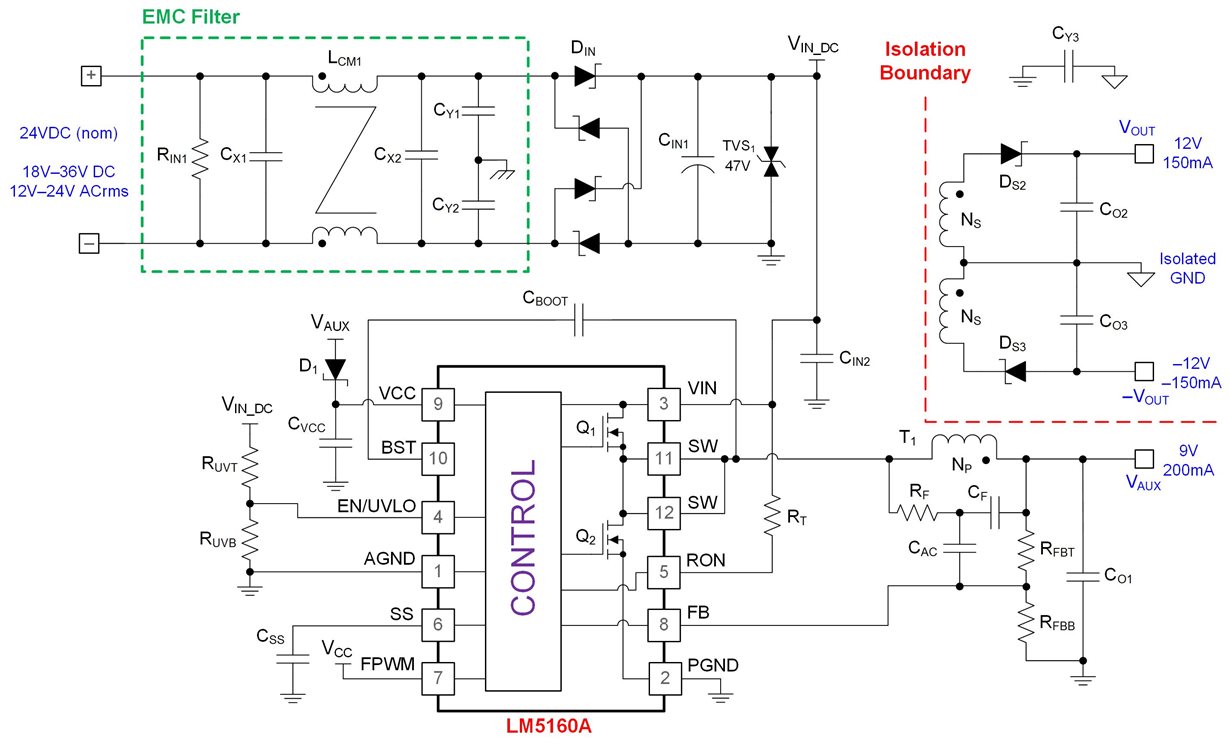SSZTCE1 July 2015 LM5085 , LM5160A , LM5161 , LM5161-Q1
Testament to its ease-of-use, small solution size, galvanic isolation, wide input voltage range, and low overall bill-of-materials cost, a properly-designed Fly-Buck™ circuit is as indispensable as it is convenient.
For example, programmable logic controllers (PLC), field transmitters, sensors and process instrumentation, industrial communication, human machine interface (HMI), and IGBT-based motor drives all have unique power solution requirements well suited to the Fly-Buck circuit. And as demanding isolated applications come to fruition, conformance to regulatory specifications is an increasingly-relevant power solution benchmark. For instance, various tests within IEC 61000-4 system-level EMC specification are related to low and high frequency disturbances (ESD, EFT/burst, lightning surge, and conducted and radiated RF immunity).
Fly-Buck Power Stage with Bridge Rectifier and Input Filter
Based on the 65V, 1.5A LM5160A synchronous buck converter, Figure 1 shows an EMC-compliant Fly-Buck power supply that delivers ±12V isolated rails from a center-tapped secondary winding. Output voltages are scaled based on the turns ratio NP/NS of transformer T1. A 9V primary-side regulated aux rail sends bias power to VCC to reduce quiescent loss at high VIN.
 Figure 1 AC or DC-powered, EMC-compliant Fly-Buck Converter Supplying Isolated ±12V Rails
Figure 1 AC or DC-powered, EMC-compliant Fly-Buck Converter Supplying Isolated ±12V RailsTransformer Isolation
Demarcated in red in Figure 1 is the isolation boundary, apropos the need to provide user safety or break a ground loop. Interleaving the primary and secondary windings improves cross regulation and minimizes leakage inductance. To customize the converter design for additional outputs, simply add a transformer secondary winding (with the appropriate turns ratio), a rectifier diode, and an output capacitor. Triple, quad, and even octal outputs are easily obtained, with a small-size magnetic component for space-constrained designs.
For basic, supplementary, or reinforced insulation, when powering digital isolators or sensing systems for example, select the magnetic component that meets the isolation grade requirement and design the PCB layout to meet the relevant creepage and clearance specification of the referencing isolation standard.
EMC Performance
The green box in Figure 1 is the EMI filter shown with common-mode inductor, X- and Y-capacitors, parallel damping resistor, and bidirectional TVS voltage clamp. Generally, the goal of EMC-protected circuits is to shunt the external transients to ground with low impedance, thus protecting the circuit from damage. A Fly-Buck converter with wide VIN capability permits a higher voltage TVS diode with lower power rating and smaller footprint to satisfy input transient immunity specifications for the power stage. Y-capacitors, denoted as CYI and CY2 in Figure 1, shunt transient energy from the input lines to the system’s chassis ground. This approach is complemented by small ferrite beads that provide high impedance at particularly sensitive nodes in the signal chain where high attenuation is required.
Fly-Buck Value Proposition
A good understanding of EMI and isolation is obligatory for all power system designers. With that in mind, I recently penned an article for TI’s Analog Applications Journal, “Fly-Buck Converter Provides EMC and Isolation in PLC Applications,” that delves into EMC and isolation requirements in more detail. In summary, the value proposition of Fly-Buck topology is its cohesive feature set that addresses a variety of power solution needs:
- Multiple converter- or controller-based IC solutions depending on input voltage and output current specifications
- Reliable synchronous buck or buck-boost based converter design
- Extra margin from wide VIN range to survive input rail transient voltages disturbances
- Small-size magnetic component ideal for space-constrained designs
- Easily modified configuration for additional outputs
- Absence of primary-side voltage spike from transformer leakage inductance reduces EMI
- Simple BOM: no loop compensation, error amplifier, or feedback opto-coupler components
So, please check out our Wide Vin portal to find out more about the Fly-Buck topology and the applicable devices within our portfolio of wide VIN controllers, converters and power modules.
Additional Resources:
- Read “Fly-Buck converter provides EMC and isolation in PLC applications” in the 1Q 2015 edition of TI’s Analog Applications Journal.
- Peruse the ever-expanding
portfolio of Fly-Buck isolated designs from the PowerLab reference design library:
- EMI optimized layout design for Fly-Buck TI Design reference design
- Isolated RS-485 to Wi-Fi bridge with 24VAC power TI Design reference design
- Leakage current measurement TI Design reference design for determining insulation resistance
-
Review several transient protection tips for EMI-sensitive loads.
- Order the isolated and non-isolated EVMs for the LM5160A synchronous buck converter.
- Watch a Fly-Buck power solution video.
- Start a design now with WEBENCH® Power Designer.